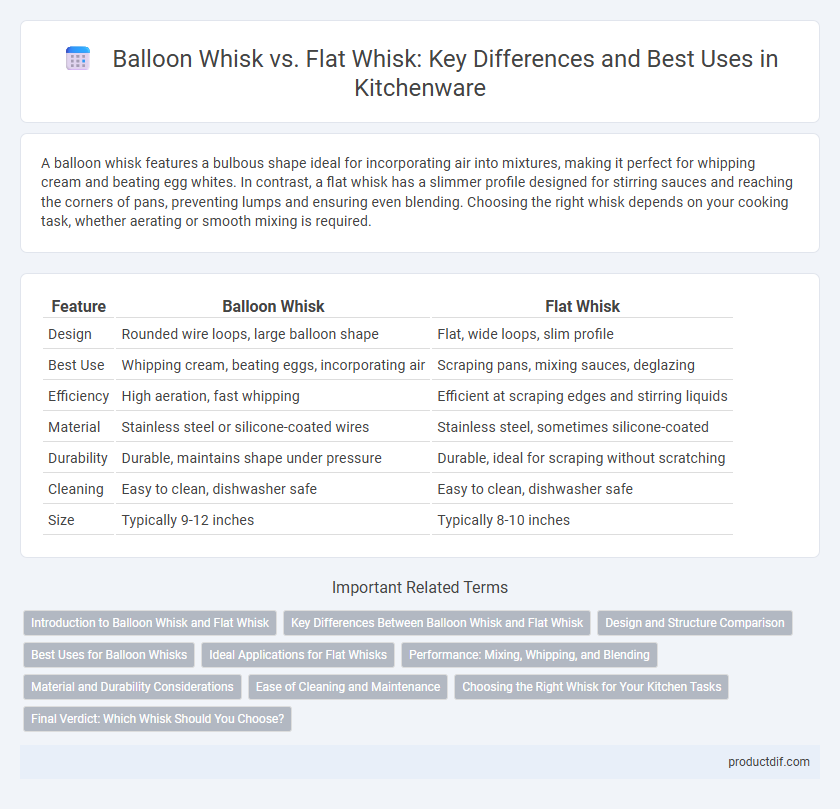A balloon whisk features a bulbous shape ideal for incorporating air into mixtures, making it perfect for whipping cream and beating egg whites. In contrast, a flat whisk has a slimmer profile designed for stirring sauces and reaching the corners of pans, preventing lumps and ensuring even blending. Choosing the right whisk depends on your cooking task, whether aerating or smooth mixing is required.
Table of Comparison
| Feature | Balloon Whisk | Flat Whisk |
|---|---|---|
| Design | Rounded wire loops, large balloon shape | Flat, wide loops, slim profile |
| Best Use | Whipping cream, beating eggs, incorporating air | Scraping pans, mixing sauces, deglazing |
| Efficiency | High aeration, fast whipping | Efficient at scraping edges and stirring liquids |
| Material | Stainless steel or silicone-coated wires | Stainless steel, sometimes silicone-coated |
| Durability | Durable, maintains shape under pressure | Durable, ideal for scraping without scratching |
| Cleaning | Easy to clean, dishwasher safe | Easy to clean, dishwasher safe |
| Size | Typically 9-12 inches | Typically 8-10 inches |
Introduction to Balloon Whisk and Flat Whisk
Balloon whisks feature a bulbous shape with numerous flexible wires, ideal for incorporating air into mixtures such as egg whites or cream to create light, fluffy textures. Flat whisks have a slim, flat design perfect for blending sauces and gravies directly in shallow pans without scratching the surface. Both types of whisks serve distinct purposes, with balloon whisks excelling in aeration and flat whisks excelling in smooth, consistent blending.
Key Differences Between Balloon Whisk and Flat Whisk
Balloon whisks feature a bulbous, rounded shape with wide, flexible wires ideal for whipping air into egg whites and cream, providing volume and lightness. Flat whisks have a thin, flat blade design suited for stirring sauces, gravies, and eggs in shallow pans, allowing efficient mixing and scraping of surfaces. The main difference lies in their wire shape and intended use: balloon whisks excel in aeration while flat whisks offer precision in stirring and deglazing.
Design and Structure Comparison
Balloon whisks feature a bulbous, rounded design with numerous flexible wires, ideal for incorporating air into mixtures like egg whites and cream, while flat whisks have a broader, flatter shape with fewer wires designed for smoothing sauces and deglazing pans. The balloon whisk's structure maximizes aeration and volume, whereas the flat whisk's shape provides better contact with pan surfaces for efficient mixing without scratching. Material choices like stainless steel provide durability and resistance to heat, with ergonomic handles enhancing control during whisking tasks.
Best Uses for Balloon Whisks
Balloon whisks excel in aerating ingredients, making them ideal for whipping cream, beating egg whites, and creating light, fluffy mixtures. Their rounded, bulbous shape maximizes air incorporation, perfect for blending batters or emulsifying vinaigrettes. Balloon whisks are best used when volume and aeration are essential in cooking or baking tasks.
Ideal Applications for Flat Whisks
Flat whisks excel in deglazing pans and stirring sauces due to their thin, flat shape that easily reaches corners and edges. Their design allows for effective mixing of roux, gravies, and custards without incorporating excess air. Ideal for tasks requiring gentle folding or smoothing, flat whisks provide greater control over texture and consistency in delicate preparations.
Performance: Mixing, Whipping, and Blending
Balloon whisks excel at whipping air into mixtures, making them ideal for beating egg whites and cream with their wide, rounded wires that maximize aeration. Flat whisks provide superior control when blending sauces or gravies, effectively reaching into corners and thin layers to prevent lumps. Both types deliver strong mixing performance, but balloon whisks are preferred for fluffy textures, while flat whisks excel in smooth, consistent blending.
Material and Durability Considerations
Balloon whisks typically feature stainless steel wires that offer excellent flexibility and resistance to rust, making them ideal for whipping air into mixtures, while flat whisks often use stainless steel or silicone-coated wires for enhanced durability and gentle mixing on flat surfaces without scratching cookware. The choice of material directly impacts longevity; stainless steel balloon whisks maintain shape under frequent use, whereas silicone-coated flat whisks withstand higher heat and prevent damage to non-stick pans. Durability considerations depend on kitchen tasks, with stainless steel providing robust performance and silicone coatings extending usability with delicate cookware.
Ease of Cleaning and Maintenance
Balloon whisks feature a rounded design with numerous wires that can trap food particles, making them slightly more challenging to clean compared to flat whisks, which have a streamlined shape that allows for easier rinsing and reduced residue buildup. Flat whisks often require less effort to maintain due to their simple structure that fits well in sinks and dishwasher racks. Choosing a flat whisk enhances kitchen hygiene with quicker, more efficient cleaning, especially when dealing with sticky or thick mixtures.
Choosing the Right Whisk for Your Kitchen Tasks
A balloon whisk features a bulbous shape with numerous flexible wires, making it ideal for whipping air into eggs, cream, and delicate sauces, while a flat whisk has a single-layered, flat design perfect for deglazing pans and stirring thin mixtures. Selecting the right whisk depends on the task: use a balloon whisk for incorporating air and a flat whisk for scraping and blending in shallow pans. Investing in both types enhances efficiency by matching whisk design to specific kitchen tasks, ensuring optimal texture and flavor in recipes.
Final Verdict: Which Whisk Should You Choose?
A balloon whisk excels at incorporating air into mixtures, making it ideal for whipping cream and beating egg whites, while a flat whisk is better suited for deglazing pans and mixing sauces with its slim, flat design. Choose a balloon whisk for tasks requiring volume and lightness and opt for a flat whisk when you need to reach into corners or stir thicker mixtures. Selecting the right whisk depends on your primary cooking needs, with both tools offering unique advantages in kitchen efficiency.
Balloon Whisk vs Flat Whisk Infographic

 productdif.com
productdif.com